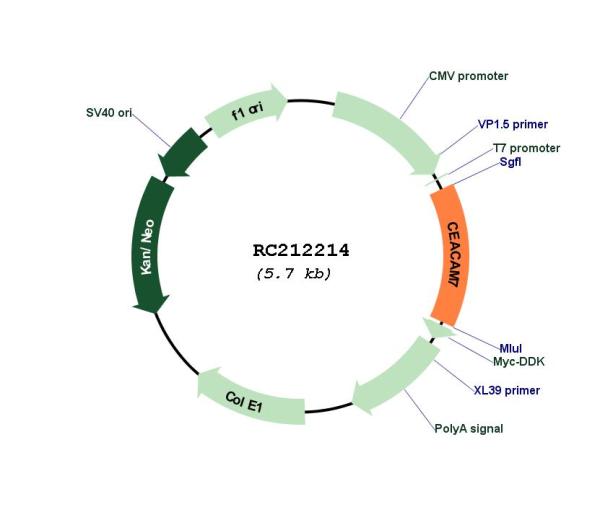CEACAM7 (NM_006890) Human Tagged ORF Clone
CAT#: RC212214
CEACAM7 (Myc-DDK-tagged)-Human carcinoembryonic antigen-related cell adhesion molecule 7 (CEACAM7)
ORF Plasmid: tGFP
Lentiviral Particles: DDK DDK w/ Puro mGFP mGFP w/ Puro
"NM_006890" in other vectors (6)
USD 198.00
Specifications
| Product Data | |
| Type | Human Tagged ORF Clone |
| Tag | Myc-DDK |
| Symbol | CEACAM7 |
| Synonyms | CGM2 |
| Vector | pCMV6-Entry |
| E. coli Selection | Kanamycin (25 ug/mL) |
| Mammalian Cell Selection | Neomycin |
| Sequence Data |
>RC212214 representing NM_006890
Red=Cloning site Blue=ORF Green=Tags(s) TTTTGTAATACGACTCACTATAGGGCGGCCGGGAATTCGTCGACTGGATCCGGTACCGAGGAGATCTGCC GCCGCGATCGCC ATGGGTTCCCCTTCAGCCTGTCCATACAGAGTGTGCATTCCCTGGCAGGGGCTCCTGCTCACAGCCTCGC TTTTAACCTTCTGGAACCTGCCAAACAGTGCCCAGACCAATATTGATGTCGTGCCGTTCAATGTCGCAGA AGGGAAGGAGGTCCTTCTAGTAGTCCATAATGAGTCCCAGAATCTTTATGGCTACAACTGGTACAAAGGG GAAAGGGTGCATGCCAACTATCGAATTATAGGATATGTAAAAAATATAAGTCAAGAAAATGCCCCAGGGC CCGCACACAACGGTCGAGAGACAATATACCCCAATGGAACCCTGCTGATCCAGAACGTCACCCACAATGA CGCAGGAATCTATACCCTACACGTTATAAAAGAAAATCTTGTGAATGAAGAAGTAACCAGACAATTCTAC GTATTCTCGGAGCCACCCAAGCCCTCCATCACCAGCAACAACTTCAATCCGGTGGAGAACAAAGATATTG TGGTTTTAACCTGTCAACCTGAGACTCAGAACACAACCTACCTGTGGTGGGTAAACAATCAGAGCCTCCT GGTCAGTCCCAGGCTGCTGCTCTCCACTGACAACAGGACCCTCGTTCTACTCAGCGCCACAAAGAATGAC ATAGGACCCTATGAATGTGAAATACAGAACCCAGTGGGTGCCAGCCGCAGTGACCCAGTCACCCTGAATG TCCGCTATGAGTCAGTACAAGCAAGTTCACCTGACCTCTCAGCTGGGACCGCTGTCAGCATCATGATTGG AGTACTGGCTGGGATGGCTCTGATA ACGCGTACGCGGCCGCTCGAGCAGAAACTCATCTCAGAAGAGGATCTGGCAGCAAATGATATCCTGGATT ACAAGGATGACGACGATAAGGTTTAA >RC212214 representing NM_006890
Red=Cloning site Green=Tags(s) MGSPSACPYRVCIPWQGLLLTASLLTFWNLPNSAQTNIDVVPFNVAEGKEVLLVVHNESQNLYGYNWYKG ERVHANYRIIGYVKNISQENAPGPAHNGRETIYPNGTLLIQNVTHNDAGIYTLHVIKENLVNEEVTRQFY VFSEPPKPSITSNNFNPVENKDIVVLTCQPETQNTTYLWWVNNQSLLVSPRLLLSTDNRTLVLLSATKND IGPYECEIQNPVGASRSDPVTLNVRYESVQASSPDLSAGTAVSIMIGVLAGMALI TRTRPLEQKLISEEDLAANDILDYKDDDDKV |
| Chromatograms |
CHROMATOGRAMS
 Sequencher program is needed, download here. |
| Restriction Sites |
SgfI-MluI
Cloning Scheme for this gene
Plasmid Map

|
| ACCN | NM_006890 |
| ORF Size | 795 bp |
| OTI Disclaimer | The molecular sequence of this clone aligns with the gene accession number as a point of reference only. However, individual transcript sequences of the same gene can differ through naturally occurring variations (e.g. polymorphisms), each with its own valid existence. This clone is substantially in agreement with the reference, but a complete review of all prevailing variants is recommended prior to use. More info |
| OTI Annotation | This clone was engineered to express the complete ORF with an expression tag. Expression varies depending on the nature of the gene. |
| Product Components | The ORF clone is ion-exchange column purified and shipped in a 2D barcoded Matrix tube containing 10ug of transfection-ready, dried plasmid DNA (reconstitute with 100 ul of water). |
| Reconstitution | 1. Centrifuge at 5,000xg for 5min. 2. Carefully open the tube and add 100ul of sterile water to dissolve the DNA. 3. Close the tube and incubate for 10 minutes at room temperature. 4. Briefly vortex the tube and then do a quick spin (less than 5000xg) to concentrate the liquid at the bottom. 5. Store the suspended plasmid at -20°C. The DNA is stable for at least one year from date of shipping when stored at -20°C. |
| Reference Data | |
| RefSeq | NM_006890.5 |
| RefSeq Size | 2292 bp |
| RefSeq ORF | 798 bp |
| Locus ID | 1087 |
| UniProt ID | Q14002 |
| Cytogenetics | 19q13.2 |
| MW | 29.2 kDa |
| Gene Summary | This gene encodes a cell surface glycoprotein and member of the carcinoembryonic antigen (CEA) family of proteins. Expression of this gene may be downregulated in colon and rectal cancer. Additionally, lower expression levels of this gene may be predictive of rectal cancer recurrence. This gene is present in a CEA family gene cluster on chromosome 19. Alternative splicing results in multiple transcript variants. [provided by RefSeq, Jul 2015] |
Documents
| Product Manuals |
| FAQs |
| SDS |
Resources
Other Versions
| SKU | Description | Size | Price |
|---|---|---|---|
| RC212214L1 | Lenti ORF clone of Human carcinoembryonic antigen-related cell adhesion molecule 7 (CEACAM7), Myc-DDK-tagged |
USD 750.00 |
|
| RC212214L2 | Lenti ORF clone of Human carcinoembryonic antigen-related cell adhesion molecule 7 (CEACAM7), mGFP tagged |
USD 750.00 |
|
| RC212214L3 | Lenti ORF clone of Human carcinoembryonic antigen-related cell adhesion molecule 7 (CEACAM7), Myc-DDK-tagged |
USD 750.00 |
|
| RC212214L4 | Lenti ORF clone of Human carcinoembryonic antigen-related cell adhesion molecule 7 (CEACAM7), mGFP tagged |
USD 750.00 |
|
| RG212214 | CEACAM7 (tGFP-tagged) - Human carcinoembryonic antigen-related cell adhesion molecule 7 (CEACAM7) |
USD 650.00 |
|
| SC303844 | CEACAM7 (untagged)-Human carcinoembryonic antigen-related cell adhesion molecule 7 (CEACAM7) |
USD 300.00 |
{0} Product Review(s)
Be the first one to submit a review






























































































































































































































































 Germany
Germany
 Japan
Japan
 United Kingdom
United Kingdom
 China
China





